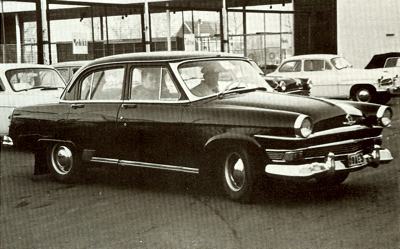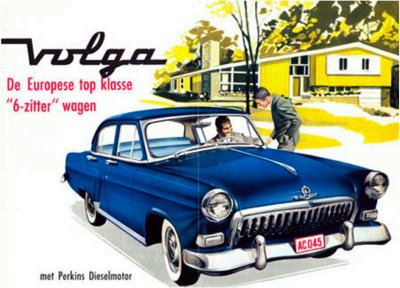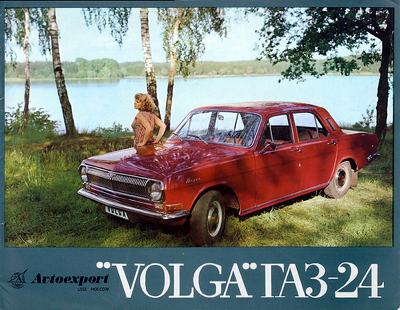Volga
|
1946 - Present |
Country: |
 |
|
VOLGA was one of the Russian car names that became known to the West as a marque in its own right during the 1970's, but in fact the cars that carried the Volga badge were part of the wider Soviet personal transportation pattern, and need to be seen in the context of this pattern.
The Great Patriotic War
The story starts in 1946, in the aftermath of what the Russian's officially call the Great Patriotic War. Starved of transport, Russia needed a rugged, no-nonsense car quickly. A design team under Andrei Lipgart came up with a
unitary-construction design with independent front suspension and semi-elliptic rear springs and rigid axle, powered by a 2.1-Iitre four-cylinder 50 bhp engine with three-speed
synchromesh gearbox
This new Russian auto was called the Pobieda (meaning Victory), and emerged from the giant Gorky car plant, it was also known by the Russians as the GAZ Mzo, Further confusing the nomenclature was the title of the Gorky manufacturing operation, Zavod Imieni Molotova, whose initials form the much more familiar ZIM name.
Although a few changes were wrought on the Pobieda, including some touring versions and a four-wheel-drive M72 version in 1955, nothing dramatic happened to the model's appearance, and after thirteen years production the Russians decided that even their severe weather and geographical conditions did not excuse the continued manufacture of the solid, stolid Pobieda.
The Warszawa
A new design, utilising Pobieda components but considerably up-dated in approach, was put into production alongside the old model. Over a three-year period the two assembly lines ran in parallel – until, in 1958, conversion was complete. The Pobieda design was pensioned off for manufacture by FSO in Poland under the name of the Warszawa, and continued until it was superseded by the
Polski-Fiat.
The new Gorky product meanwhile became known in the West as the Volga, and it was this title that would become familiar name in export markets. To the Russians it was the GAZ MZL - another Lipgart creation, it was one of the very first cars to use light alloys in mass-produced engines, and also pioneered the use of five main bearings in a four-cylinder engine. It displaced 2.5 litres, was of over-head-valve configuration, employed wet cylinder liners, and was offered with either a 70 or 97 bhp power plant under the bonnet.
The GAZ M24
Automatic transmission was introduced in 1959, but was not a success. Subsequent changes were confined mainly to grille design, and M22G wagon and M22E ambulance versions were later added to the range. The Volga saloon, as the Pobieda before it, became one of Russia's most popular taxis. In Belgium the import firm, Sobimpex installed a 65 bhp Rover diesel as an option. The next Volga development emerged in 1968 the GAZ M24 or Volga 24, with lower lines and longer wheelbase. Output was up to 11O bhp, with drive through a four-speed all-synchromesh gearbox with floor-mounted gear change.
The Volga 24 completely supplanted the older car by 1971, and became highly regarded within the Eastern bloc, winning gold medals at the Plovdiv and Brno international exhibitions, and taking a class win the Taurus-73 rally: none of which achievements were communicated to the West, but nor would they have meant much even if they had been. The Gorky factory was then extended to accommodate manufacture of a new V6 2.5-litre 160 bhp sealed-unit engine, designed to be opened for overhaul only every 150,000 kilometres. This engine was designed by NAMI, the Moscow vehicle research centre, for the Volga 24 and for a four-wheel derivative called the Volga Universal.
 The 1961 Volga 4-door showed just how much the Russian motoring industry copied that of the USA.
The 1961 Volga 4-door showed just how much the Russian motoring industry copied that of the USA.

 |
ZIS, ZIL and ZIM
In 1973 a 24-02 wagon car version of the Volga saloon was introduced with three rows of seats, and giving accommodation for a driver plus seven passengers or a driver, with the two rear seats in reclining positions, one passenger and 500 kg of cargo. It seemed the Russian car industry was fairly tidy about which factory built which sort of vehicle. The Volga became the nation's taxi. Arguably better motoring fare was then provided by ZIS, ZIL and ZIM cars (each named after the factory that produced them).
The medium market was originally supplied by Moskvich, then Aporozhets and the Fiat-based Lada opened up new light-car areas. Quality may have not met Western standards, but the Russian car industry seemed to know exactly who was doing what, and wasteful internal competitive effort was avoided. To eastern eyes the results of the well-regulated and competition-free industry showed in the cars, but Russian designers needed more of a challenge, and set about demonstrating that they could learn how to meet worldwide standards of finish and performance - although few would argue that they actually came anywhere near close.
The Volga the GAZ-3102
In 1982 GAZ introduced the third generation of the Volga the GAZ-3102. However this car was limited to the public and production of the old series continued, lacking a suitable replacement GAZ undertook a deep upgrade of the -24, utilising many of the -3102 features. This resulted in an entirely new car, which was produced right up to the early 1990s. Externally the changes affected the new model losing nearly all of its chromed detail via a new plastic grill, new "sunken" door handles. The front door windows no longer had corner leafs, whilst new plastic wing mirrors were now featured on both driver and passenger sides. Inside the old ZMZ-24 was replaced with a derived ZMZ-402 engine, which introduced a new carburator and cooling mechanism allowing a 98 hp output (from 85 hp on the -24).
The 24-10 received a new suspension which allowed for larger wheels, with a new rim as standard and also had a new set of vacuum amplified brakes. Some of the cars were fitted with disk
brakes from the -3102. Inside the car received a completely new interior, based on the foreign models of the 1980s, including dashboard controls and headrests on seats. Like the base -24 the car had several modifications including an wagon GAZ-24-12 introduced in 1987, and a low-production V8 powered GAZ-24-34. The most significant impact of the car was that, unlike the 3102 which was sold primarily for state institutions and corporations, the GAZ-24-10 was exactly opposite, which meant that many private owners wishing for a mid-size car could now acquire one with relative ease. However on the whole, even at its introduction the car was very out of date compared with its western rivals and production ceased in 1992. According to GAZ 1,481,561 cars of the -24 series were produced from 1970 until 1992 making it the highest in history of the plant.
The GAZ-31029
By the start of the 1990s, GAZ was in a crises state, with the exception of the -3102, its models were more than a decade old and funds that it hoped to acquire for its future developments such as the -3105 never arrived. GAZ-31029 became a cross-breed of the GAZ-3102 and GAZ-24-10, production of which ceased in 1992. The new model had a more
aerodynamic front bodywork. The model was also the first in the series to introduce injector engine ZMZ-4062.10 with four
valves per cylinder, although carburettor engines were also available. Also unlike the 3102, the 31029 featured a station wagon. The latter, unlike the sedan, still retained most of the rear styling of the -24 series.
Initially the car enjoyed popularity, given the archaic age of the GAZ-24-10 it replaced, but the economic hardships of the 1990s meant that soon its reputation would be broken by the poor quality of assembly and corrosion problems, and the older 3102, still produced on the special conveyor was soon given preference after it was made available to the public following the collapse of the Soviet Union. Despite this and its short production run, GAZ set a record of more than 115 thousand per annum with the 31029.
The GAZ-3110
GAZ never intended the 31029 to be a permanent model, but with no replacement available, the company opted to continuously modernise the existing vehicle. In 1996, the GAZ-3110 arrived, in the new model, GAZ tried to upgrade the car to a new standard inline with the 1990s trends. Externally all except the door panels were re-styled and replaced. The car received new front and rear designs which saw the return of chrome finishes. Power-assisted
steering became standard, along with new 15-inch wheels and
Lucas brakes.
A major new feature of the 3110 was that in addition to the standard engine selection of the 31029, was the introduction of two diesel engines ZMZ-560 and ZMZ-561. Moreover beginning in 2001, following the upgrade at GAZ factory itself, the -3110 now received modern acrylic paintwork, which drastically reduced the corrosion problems that plagued the Volgas. In 2003 the 3110 received ball-joint front suspension, also Steyr
turbo diesel engines became available. The wagon version of the 3110, the Volga 310221, along with the 310223 ambulance, remains in production as of 2008 along with the GAZ-3102 on its separate conveyor line.
Also see: GAZ Car Reviews |
ZIS and ZIL Car Reviews |
Polski Fiat 


